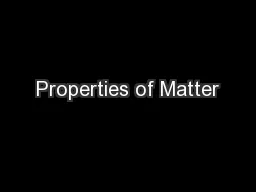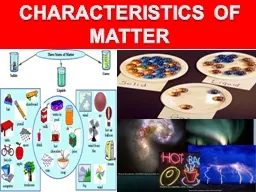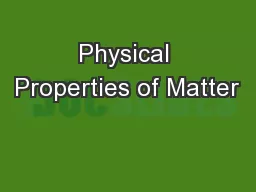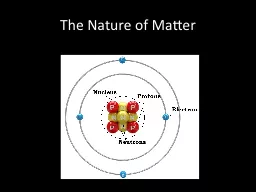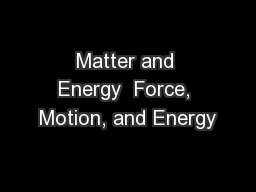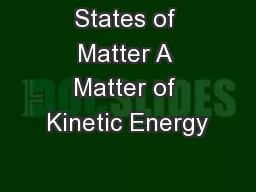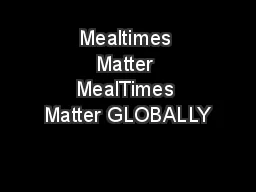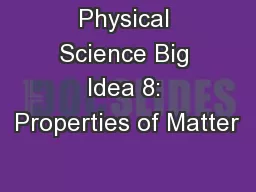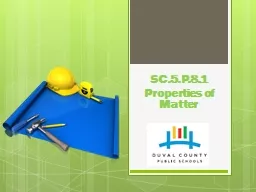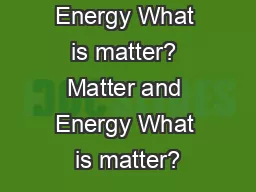PPT-Properties of Matter
Author : giovanna-bartolotta | Published Date : 2017-03-24
Matter All matter has two types of properties Physical properties Chemical properties Physical properties A physical property is a characteristic of a substance
Presentation Embed Code
Download Presentation
Download Presentation The PPT/PDF document "Properties of Matter" is the property of its rightful owner. Permission is granted to download and print the materials on this website for personal, non-commercial use only, and to display it on your personal computer provided you do not modify the materials and that you retain all copyright notices contained in the materials. By downloading content from our website, you accept the terms of this agreement.
Properties of Matter: Transcript
Matter All matter has two types of properties Physical properties Chemical properties Physical properties A physical property is a characteristic of a substance that can be observed without changing the substance into another substance. Intensive vs. Extensive. Essential Standard. 6.P.. 2 Understand . the structure. , classifications . and physical properties of matter.. Clarifying Objective. 6.P .. 2.3 Compare . the physical properties of pure substances that . Matter. Kinetic Theory. Solid. Liquid. Gas. Plasma. Phase change. Freezing. Melting. Deposition. Sublimation. Condenstation. Vaporization. Physical properties. Ducility. Malleability. Melting point. Boiling point. What is the Matter?. Stuff of which all materials are made out of. Anything that has mass and takes up space. .. WHY ARE WE CONCERNED WITH MATTER??. Chemistry is the science concerned with the properties, composition, and behaviour of matter!. TEK 5.5 A – Students will classify matter based on physical properties…. Matter. Matter. is any living or non-living thing in the universe. All objects, things, plants, people, animals, etc are made up of matter. What is matter? . Matter: . Anything that . hass. mass and volume . Matter can be measured in these ways: . Volume: amount of space that matter takes up . Mass: a measure of matter’s inertia (more mass = greater inertia) . &. Matter and Energy. . Main Idea. You will be able to . demonstrate. . an understanding of the properties of matter and energy and their interactions.. [8 questions on STAAR]. Matter has measurable physical properties. . 8/28/17. Matter. Anything that has mass and takes up space. Substance. A single kind of matter that always has a specific makeup or composition. Describing Matter. We describe matter using its properties. of Mathematics and Science. Office of Academics and Transformation. Big Idea 8. SC.4.P.8.1. Benchmark Descriptions. SC.4.P.8.1 – Measure and compare objects and materials based on their physical properties including: mass, shape, volume, color, hardness, texture, odor, taste, and attraction to magnets. Types of States of Matter. Solid. Liquid. Gas. Plasma. Beam. BEC, or Bose-Einstein Condensate. Zero State of Matter. Most Dense. Changes of State. Kinetic Energy (. kelvins. & . paschals. ). chemwiki.ucdavis.edu/. Its building on. Protected Meal Times. REMEMBER ITS EATING FOR GOOD HEALTH NOT HEALTHY EATING. The Challenges. Fact. Many Different Routes . being taken. A Brief History. “When a person is compelled, by the pressure of occupation, to continue his business while sick, it ought to be a rule . Element – a substance that is made up of one type of atom. Evaporation – is a change of state from a liquid to a gas. Solid – has a definite volume and shape. Define the following the words:. Physical Property – can be measured without changing the identity of a . Grade 1 Topic 2 . Observable Properties. Division of Academics - Department of Science. Grade 1 Pacing . Guide Properties . of Matter . Benchmarks. SC.1.P.8.1 . Sort objects by observable properties, such as size, shape, color, temperature (hot or cold), weight (heavy or light), texture, and whether objects sink or float. SC.5.P.8.1. Benchmark: . . Compare and contrast the basic properties of solids, liquids, and gases, such as mass, volume, color, texture, and temperature. . Essential Question:. What are the similarities and differences of the basic properties of solids, liquids, and gases?. Matter and Energy What is matter? Matter and Energy What is matter? It's what everything that occupies space and has mass is made of And everything like that is made out of chemical elements There are 92 naturally occurring chemical elements, and a number of synthetic ones
Download Document
Here is the link to download the presentation.
"Properties of Matter"The content belongs to its owner. You may download and print it for personal use, without modification, and keep all copyright notices. By downloading, you agree to these terms.
Related Documents

